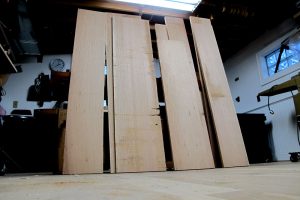We may receive a commission when you use our affiliate links. However, this does not impact our recommendations.
Around the Popular Woodworking Magazine office we used to joke about how red oak (Quercus rubra) wasn’t really a wood. It was more like a weed. It’s stringy, kinda homely, cheap and – most of all – everywhere.
I have been in far too many kitchens around the world where every piece of wood that wasn’t painted was red oak. When my sister-in-law asked me how to improve the look of her red oak cabinets, I offered a two-word answer: paint or fire.
So this week I’m buying wood for my next project, a campaign-style folding bookcase. Even after building the massive Monticello bookcase for my library, I still have need for about 40’ more linear feet of shelving.
I’m a long-time fan of campaign furniture. It’s simple, strong and manly, like me. Well, one out of three ain’t bad.
Whenever I build a project such as this, I tend to do a bunch of research so that I have a basic understanding of the style and form. It’s like studying a language before you travel abroad. You might not be fluent and fool the locals, but at least you won’t end up eating monkey brains at a restaurant.
If you look only at auction catalogs, you might think that all campaign furniture was made from teak or mahogany. And to be sure, a lot of it was made using those exotic woods. But not all. Primary sources – such as advertisements and period catalogs – also indicate that oak was widely used in these pieces. And sometimes walnut.
So when I went to the lumberyard this morning to buy wood I took my cutting list, a tape measure and an open mind. I never calculate board footage and just order that amount – plus waste – from the yard. Every time I’ve done that, I’ve ended up with more waste.
I’d rather pay more for the wood and pick every stick myself than pay less and let someone else do it. The last time I let the lumberyard pick my stock, a fellow employee was in a spat with the yard. And when the yard’s employees brought out my 150-board-feet of cherry it was more sapwood than hardwood.
I asked for a refund. They refused.
“Sap,” the guy said, “is not a defect.”
So this morning I spent more than 90 minutes picking through the boards at the yard. The teak looked like crap. And at $11 a board foot, it had better be gold-plated poo. The mahogany wasn’t much better. There were some good wide boards in the racks, but not enough to make me pull the trigger.
So I started looking at the quartersawn white oak. Even though I can’t get English oak, I know that I can give American oaks a deep reddish-brown color thanks to experiments that David Thiel and I did with dye, glaze and stain in the 1990s.
The quartersawn oak was so narrow I was going to have to glue up a lot of panels to make the project work. And flatsawn oak is just ugly to my eye.
So I crossed the tracks, the Rubicon and myself as I headed over to the red oak rack. I was stunned. The rack was full of quartersawn red oak, including some 16”-wide boards with zero defects and arrow-straight grain. I grabbed the 16”s and snagged some 8”-wide boards that were also perfect. All were less than $4 a board foot.
I have never been so inspired by red oak. There must have been a crow in its branches.
So paint the crow and fire it up.
— Christopher Schwarz
If you like building things with quartersawn oak (like I do), then you’ll appreciate Robert W. Lang’s “Shop Drawings for Craftsman Furniture” as well as the other books in his series. These books are for people who really build stuff – not for the coffee table. Highly recommended.
Here are some supplies and tools we find essential in our everyday work around the shop. We may receive a commission from sales referred by our links; however, we have carefully selected these products for their usefulness and quality.










Ok, Schwarz, this time you have gone too far! What could you possibly have against red oak?
Are you making such negative remarks just because it is plentiful?
“Have you no sense of decency , sir? At long last, have you no sense of decency?”
I’m not a red oak junkie either, but I just bought some quartersawn red oak for a cradle I’m making, and frankly, that’s some sexy stuff. I think, though, that my Canadian red oak (and northern US) may look a wee bit different due to our long, cold winters which would result in tighter growth rings. Shop around a bit and you may be pleasantly surprised.
The crow was there for you to eat, after all that time dissing red oak.
I have worked with enough red oak to know it’s not my fave, but it can be good stuff for certain projects. It’s stringy and splintery and often smells like tomcat pee when you cut it, but it’s tough and can be planed to a nice finish. And the non-wood-snobs (i.e., anyone other than us crazy wooddorker types) for some reason seem to love “jenn-yew-wine oak!”. My first couple of “real” woodworking projects were red oak.
And as you observe, if you get some nice, clear quartersawn stuff, it can actually be made to serve as a passable substitute for its white brother.
Well, Chris, and then there’s the fact that there’s red oak and Red oak. As with white oak, what the trade calls red comprises quite a few species. The standard lumber-yard red oak here in Dallas is sort of pinkish color. I don’t know what species they actually use for the most part. Then there is the oak from my parent’s forest — storm -topped trees in a virgin Illinois forest — which would be classed as a red but is actually Black Oak, Quercus Velutina. It has the richest reddish brown I have seen in an American oak, and lovely figure when quarter-sawn.
Along with that was about 1400 bdft of old growth white oak Quercus Alba — but the idiot sawyer failed to cut one single quarter sawn piece after being specifically asked to quarter saw as much as he could. I guess he didn’t know what I meant? I got quarter sawn boards in the black oak because he just cut it through and through.
From that same storm, I also logged out 1200 btft of old-growth walnut that yielded a lot of good wood including a few 10 ft long by 16 to 18 inch wide clear boards.
Pretty much literally an ill wind that blew good to me.
Another white oak that I like is Bur Oak. Got some of that from a storm in Minnesota. It was not a huge tree, but growth is slow in the far north, so the grain is remarkably tight for oak. It is lovely wood and quite different from Quercus Alba although classed under the same name by the trade.
Strangely enough, whenever I show customers sample boards for projects I usually break out half a dozen or so small boards in different species that are half finished and half unfinished (qs white oak, mahog, red oak, maple, mesquite, cherry, walnut). This lets them decide on the wood. I also use the boards to show weights and in a couple of cases, cleanliness of joinery. At any rate, customers often pick red oak. I don’t know why… but they just seem to like it. It costs less, but because of the difficulties in working it, I usually end up charging almost as much as genuine mahogany or curly maple… and they still don’t mind. As my profit margin is higher (though so is my stress factor) I usually don’t mind either.
Lawrence
Lawrence
I’m kinda surprised at the red oak hate. I absolutely love the stuff. I like the grain pattern, even flat sawn, and the natural color. I also like working with it.
Maybe I’m weird though. I’m always impressed by how elegant white pine can be with decent design and some care in working it. I won’t stain it, I just brush on a couple of layers of amber shellac, and a couple more of polyurethane. My favorite project to date is a coffee table made from white pine for a friend.
Chris,
Your intro made me feel like you were becoming a wood prude. Here in New Mexico our choices are dimensioned construction grade lumber, ponderosa pine, mesquite, and occasionally some “good” red oak stock. Ordering wood from our local suppliers is expensive, time consuming, and was as you said, mostly sapwood. I have a quartersawn white oak story that would fill several volumes in a horror novel. Recently I was able to score some really nice walnut while on a trip to NY state. I was in awe of their just “stock” materials. Living in the middle of hardwood and lumber mill heaven has spoiled you, I think.
Bill
U understand, I am not an oak man either but for the past year doing projects for others I have been working strictly with oak, yuck!! I get giddy when I get to use poplar as my secondary, thats just sad. What is the finish you are going to use on yours? Merry Christmas
Chris,
Can you elaborate on the process of dyeing that you talked about (or direct me to a link)?
Makes me quite jealous that your third or fourth choice was quarter sawn red oak for $4 a foot. I live in Washington state stock like that is simply unavailable for any price.
I’m about 50% completed on a bench top tool chest inspired by the upper cabinet picture from that campaign piece you showed a photo of in your Survival of the Simplest article.
It’s reclaimed oak and although it won’t win any awards, it’s coming out pretty nice.
Thanks for the tip Chris, and keep up the good work.
Eric
Take home lesson: width trumps species.
I’m with you on this one, Chris.
Parenthetically, all three attributes of campaign furniture are also true of you, while only the third property of Red Oak fits.
Merry Christmas, Sir.